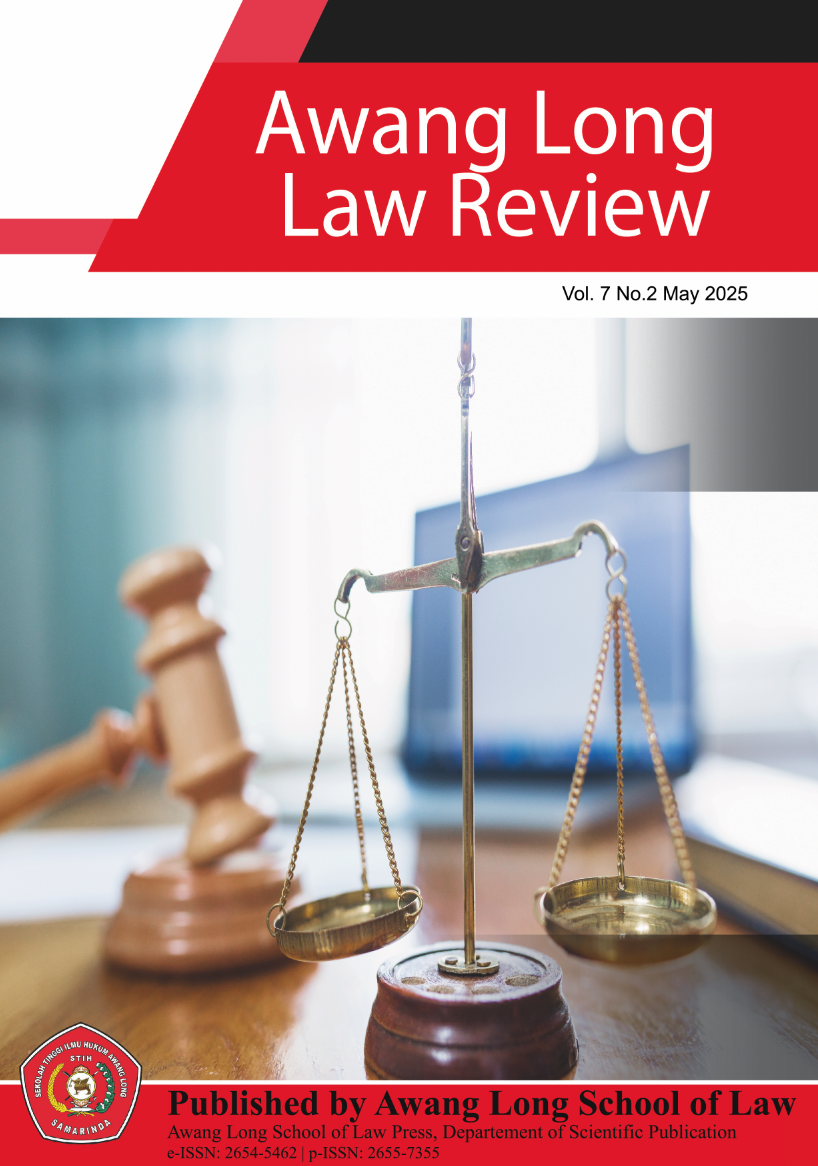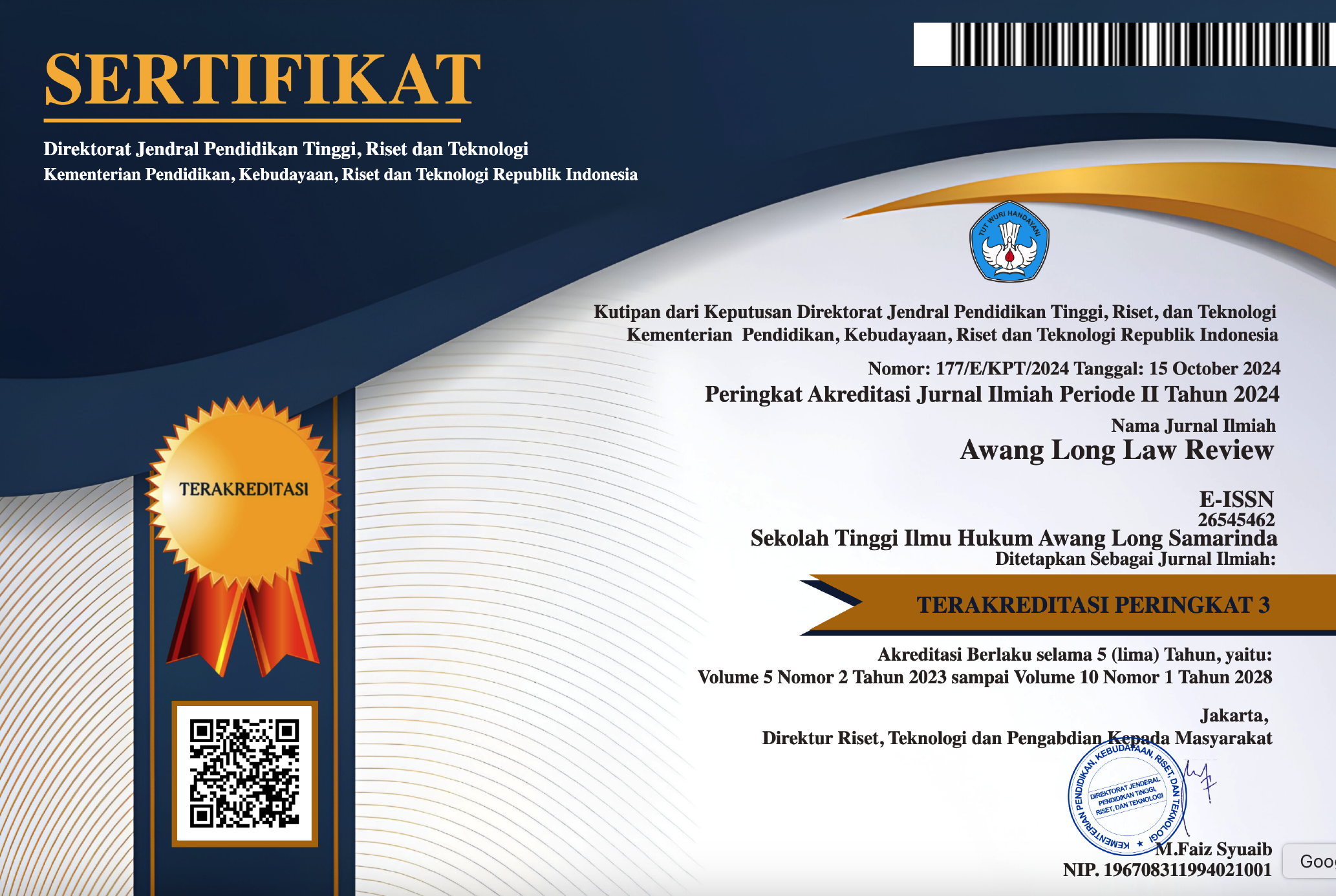UNDERSTANDING THE MECHANISM OF JOINT PROPERTY DIVISION: RIGHTS OF HUSBAND AND WIFE ACCORDING TO MARRIAGE LAW IN INDONESIA
Abstract
The mechanism for dividing joint assets in marriage law in Indonesia still occurs due to differences in its implementation. Court decisions often rely on consideration of financial contributions, but non-financial contributions are not properly recognized. Inaccuracies in judges' decisions and the lack of public understanding of the law are the main factors influencing the uncertainty of the division of joint assets after divorce. This study aims to analyze the mechanism of division of joint property in marriage law in Indonesia and identify the factors that influence the process. The focus of this study is to examine financial and non-financial contributions considered in court decisions, and differences in legal interpretation can affect the results of the division of joint assets. This study uses empirical research methods with qualitative and quantitative approaches. A total of 30 divorce cases have been analyzed in district courts and religious courts to understand the pattern of division of joint assets in legal practice. The results of the study show that although most court decisions prioritize financial contributions in the division of joint assets, non-financial contributions have not been estimated. Other influencing factors are property owners, access to legal examination, and recognition of two rights. More comprehensive rules and regulations are needed for the distribution of joint assets. An important step towards a fair and transparent legal system is the reform of the judicial system and legal training for married couples.
Downloads
References
Chen, S., He, Y., Wang, L., Shang, H., Yang, X., & Yin, Y. (2024). Architectural characterization and 3D geological modeling of Ordovician carbonate reservoirs in Shunbei No. 1 fault zone, Tarim Basin. Lithologic Reservoirs, 36(2), 124–135. Scopus. https://doi.org/10.12108/yxyqc.20240212
Dayarathna, S., Senanayake, R., Smith, P., & Evans, J. (2024). Frequency Permutation Subsets for Joint Radar and Communication. IEEE Transactions on Wireless Communications, 23(2), 1143–1157. Scopus. https://doi.org/10.1109/TWC.2023.3286410
Gautam, B., & Mehndiratta, S. (2025). Analysis of a Rock Slope with an Infilled Planar Joint Using Deterministic and Probabilistic Approaches. Indian Geotechnical Journal, 55(1), 191–199. Scopus. https://doi.org/10.1007/s40098-024-00925-6
Guo, Q., Wang, Y., Xiang, J., & Zhong, Y. (2024). Complex Gaussian Ratio-Based Bit Error Probability Calculation for PAM-FBMC Systems. IEEE Communications Letters, 28(4), 788–792. Scopus. https://doi.org/10.1109/LCOMM.2024.3362332
Hu, Z., Ye, Q., Huang, Y., Hu, S., & Yang, G. (2024). Joint Range-Velocity-Azimuth Estimation for OFDM-Based Integrated Sensing and Communication. IEEE Transactions on Wireless Communications, 23(10), 12933–12948. Scopus. https://doi.org/10.1109/TWC.2024.3397312
Jiang, Y., Gao, F., & Jin, S. (2024). Electromagnetic Property Sensing: A New Paradigm of Integrated Sensing and Communication. IEEE Transactions on Wireless Communications, 23(10), 13471–13483. Scopus. https://doi.org/10.1109/TWC.2024.3401859
Jiang, Y., Gao, F., Jin, S., & Cui, T. J. (2025). Electromagnetic Property Sensing in ISAC with Multiple Base Stations: Algorithm, Pilot Design, and Performance Analysis. IEEE Transactions on Wireless Communications. Scopus. https://doi.org/10.1109/TWC.2025.3530946
Johannsen, N.L., Schurwanz, M., Grundmann, L., Mietzner, J., Manteuffel, D., &Hoeher, P.A. (2024). Joint Communication, Sensing, and Localization in Airborne Applications: Waveform Design and Multi-Mode Multi-Port Antennas. IEEE Access, 12, 168557–168567. Scopus. https://doi.org/10.1109/ACCESS.2024.3493428
Kofidis, E. (2024). ADAPTIVE JOINT CHANNEL ESTIMATION/DATA DETECTION IN FLEXIBLE MULTICARRIER MIMO SYSTEMS - A TENSOR-BASED APPROACH. ICASSP IEEE Int Conf Acoust Speech Signal Process Proc, 8721–8725. Scopus. https://doi.org/10.1109/ICASSP48485.2024.10448468
Lei, D., Zhang, Y., Lu, Z., Liu, B., & Lin, H. (2024). Hybrid data-driven model for predicting the shear strength of discontinuous rock materials. Materials Today Communications, 41. Scopus. https://doi.org/10.1016/j.mtcomm.2024.110327
Li, C., Liu, Q., Thomas Hou, Y., Lou, W., & Kompella, S. (2024). Aequitas: A 5G Scheduler for Minimizing Outdated Information in IoT Networks. IEEE Internet of Things Journal, 11(13), 23322–23335. Scopus. https://doi.org/10.1109/JIOT.2024.3384832
Li, Z., Hu, F., Li, Q., Ling, Z., Chang, Z., & Hamalainen, T. (2024). AoI-Aware Waveform Design for Cooperative Joint Radar-Communications Systems with Online Prediction of Radar Target Property. IEEE Transactions on Communications, 1–1. Scopus. https://doi.org/10.1109/TCOMM.2024.3392748
Liu, D., Wang, Biodegradable Piezoelectric-Conductive Integrated Hydrogel Scaffold for Repair of Osteochondral Defects. Advanced Materials, 36(45). Scopus. https://doi.org/10.1002/adma.202409400
Mishra, M., Patra, S. K., &Turuk, A. K. (2024). Cumulative-Based Performance Analysis of 5G and 6G Communication Networks. In Development of 6G Networks and Technology (pp. 93–113). Wiley; Scopus. https://doi.org/10.1002/9781394230686.ch4
Mosayyebi, E., Albaghdadi, B.M.H., Ghiasvand, A., Guerrero, J.W.G., & A-Derazkola, H. (2024). Investigation of the effect of loading angle on mixed-mode fatigue crack propagation of AA2024-T351 friction stir welded joint. International Journal on Interactive Design and Manufacturing, 18(4), 2545–2558. Scopus. https://doi.org/10.1007/s12008-023-01675-0
Panwariya, C., & Dwivedi, D. K. (2024). Efficacy of Stationary Shoulder Friction Stir Welding to Minimize the Abnormal Behavior of Grain Growth in 7075 Aluminum Alloy. Journal of Materials Engineering and Performance. Scopus. https://doi.org/10.1007/s11665-024-10400-1
Reddy, S. V. B. K., & Kumar, C. S. (2024). A Hybridized Particle Swarm – Gray Wolf Optimization (PS-GWO) Mechanism for the Design of OFDM-LFM Signals in MIMO Systems. International Journal of Intelligent Systems and Applications in Engineering, 12(2), 160–174. Scopus.
Reddy, S. V. B. K., & Kumar, C. S. (2024). An Ameliorated GWO-SQP Model for Enabling an Effective Radar Communication in MIMO Systems. International Journal of Intelligent Systems and Applications in Engineering, 12(11s), 278–289. Scopus.
Rodrıguez, A., Foronda, D., Córdoba, S., Felipe-Cordero, D., Baonza, A., Miguez, D.G., & Estella, C. (2024). Cell proliferation and Notch signaling coordinate the formation of epithelial folds in the Drosophila leg. Development (Cambridge), 151(8). Scopus. https://doi.org/10.1242/dev.202384
Shao, X., Zhang, R., Jiang, Q., Park, J., Quek, TQS, & Schober, R. (2025). Distributed Channel Estimation and Optimization for 6D Movable Antenna: Unveiling Directional Sparsity. IEEE Journal on Selected Topics in Signal Processing. Scopus. https://doi.org/10.1109/JSTSP.2025.3539085
Tharranetharan, S., Soman, SKO, & Lampe, L. (2024). Joint Fiber Nonlinearity Mitigation and Compensation for Digital Sub-Carrier
Copyright (c) 2025 Esti Royani, Kamaluddin, Sarikun, Isnawati, Syamsudin

This work is licensed under a Creative Commons Attribution-ShareAlike 4.0 International License.







